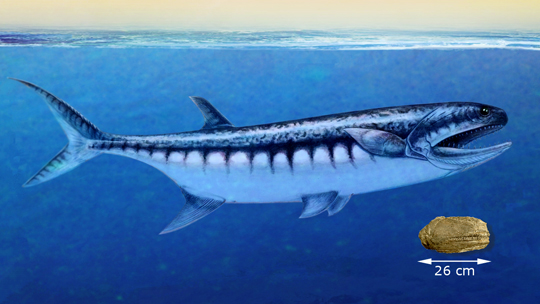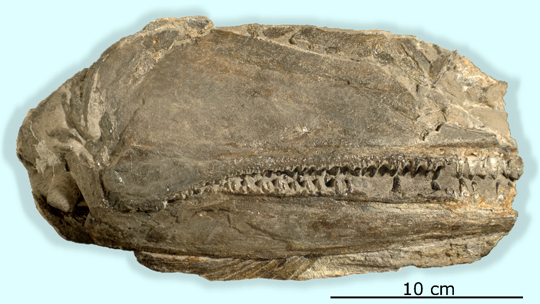The “Jaws” of the Early Triassic
Birgeria americana – Big Mouthed Fish of the Early Triassic
Birgeria americana – the jaws of the Early Triassic.
The end-Permian mass extinction event is widely regarded as the most devastating extinction known from the Phanerozoic Eon. An estimated 57% of all marine families died out, virtually all the corals became extinct and ecosystems were effectively destroyed. Notable casualties were the Trilobita, sea-scorpions (eurypterids) and many kinds of fish. Life on land did not fare any better with many groups of amphibians and reptiles perishing.
Recently, some evidence has emerged that ecosystems bounced back remarkably quickly after this catastrophic event. Further evidence of a speedy recovery comes in the form of a large fossilised skull from a new species of predatory marine fish discovered by palaeontologists from the University of Zurich during field work in Nevada.
Birgeria americana –A Top Marine Predator of the Early Triassic
Picture credit: Nadine Bösch
The new species has been named Birgeria americana, a member of the ray-finned fishes (Actinopterygii) and fossils of this genus are mostly associated with Middle Triassic, much younger rocks, but the lineage can be traced back into the Late Permian. Intriguingly, most species are much smaller, less than a metre in length, Birgeria americana in contrast, was a relatively giant, measuring around 1.72 to 1.85 metres long.
The “Jaws” of the Early Triassic
Recovered from rocks that have been dated to less than one million years after the end Permian extinction event, the discovery of such a large, voracious predator came as something of a surprise to the researchers.
Lead author of the study, recently published in the “Journal of Paleontology”, Dr Carlo Romano (Palaeontological Institute and Museum, University of Zurich) stated:
“The surprising find from Elko County in north-eastern Nevada is one of the most completely preserved vertebrate remains from this time period ever discovered in the United States.”
The new species has been described on the basis of a twenty-six-centimetre-long partial skull and jaws. The jaws contain three parallel rows of robust, sharp teeth, the largest of which were up to two centimetres long. This formidable dentition was further reinforced by several small teeth inside the mouth.
The Fossil Skull of B. americana
Picture credit: University of Zurich
Hunting Like a Great White Shark
The research team postulate that this species of super-sized Birgeria hunted in a similar fashion to the extant Great White Shark (Carcharodon carcharias). Prey fish were pursued and then bitten, resulting in massive blood loss for the victim. The unfortunate prey was then swallowed whole. The partial skull, preserved in a limestone nodule, was excavated from Lower Triassic beds close to Winecup Ranch in Elko County (Nevada). The area is famous for its Triassic vertebrate fossils including early ichthyosaurs.
Prior to this discovery, researchers had assumed that ancient equatorial regions were too hot for vertebrates to survive during the Early Triassic (Nevada was close to the equator during the Early Triassic), the discovery of such a large, obvious predator suggests a rich and diverse food chain existed even at low latitudes.
Finds such as the newly discovered Birgeria species and the fossils of other vertebrates now show that marine hypercarnivores existed shortly after the end-Permian mass extinction. The existence of bony fish close to the equator, where Nevada was located some 250 million years ago, indicates that the temperature of the sea was a maximum of 36°C. The eggs of today’s bony fish cannot develop normally at constant temperatures above 36°Celsius.
Ecosystems Recovering After a Mass Extinction Event
Dr Romano added:
“The vertebrates from Nevada show that previous interpretations of past biotic crises and associated global changes were too simplistic. Despite the severity of the extinctions of that time and intense climatic changes, the food webs were able to redevelop faster than previously assumed.”
For an article on fossil finds from China, providing further evidence of marine biota recovery following the end-Permian mass extinction: Window into an Ancient Marine Ecosystem.
The scientific paper: “Marine Early Triassic Actinopterygii from Elko County (Nevada, USA): Implications for the Smithian Equatorial Vertebrate Eclipse” by Carlo Romano, James F. Jenks, Romain Jattiot, Torsten M. Scheyer, Kevin G. Bylund, and Hugo Bucher published in the Journal of Paleontology.
Visit the Everything Dinosaur website: Everything Dinosaur.



